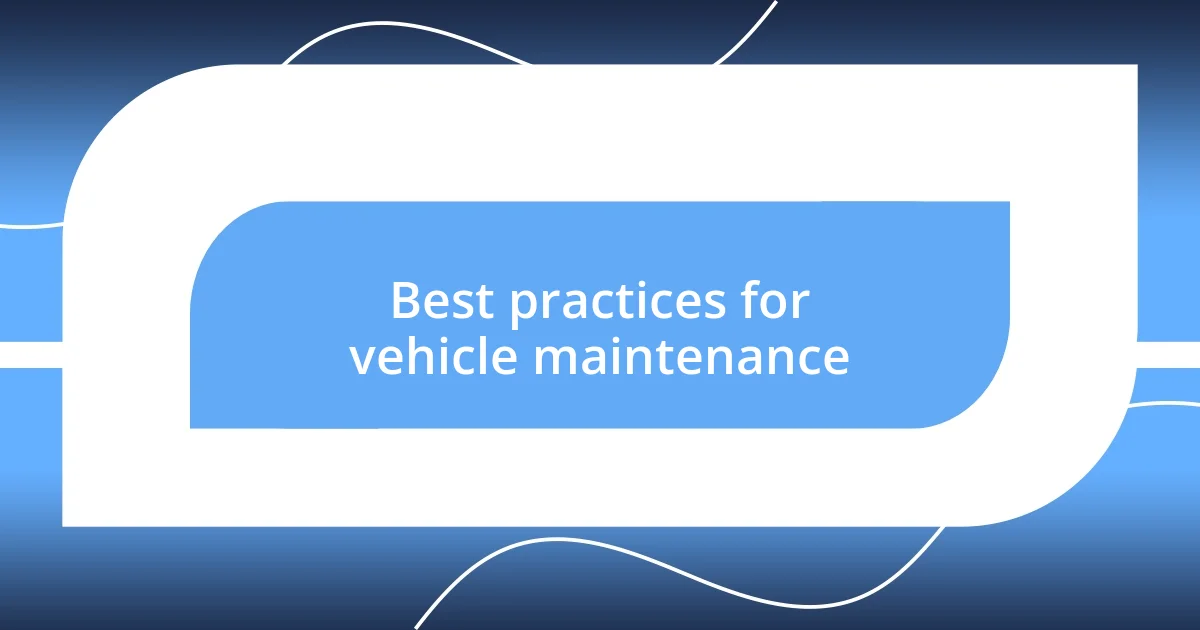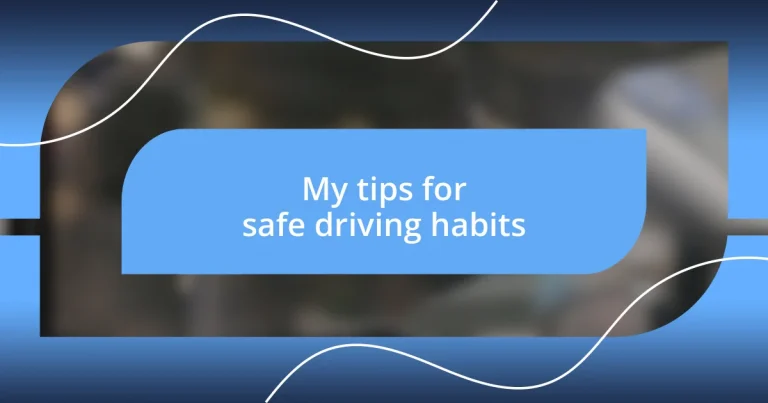Key takeaways:
- Safe driving requires attentiveness and responsibility, including maintaining a safe following distance and adhering to speed limits.
- Defensive driving techniques enhance safety by promoting awareness and patience, reducing the likelihood of accidents for all road users.
- Regular vehicle maintenance and managing distractions, like limiting phone use and organizing the in-car environment, are crucial for ensuring a safe driving experience.

Understanding safe driving habits
Understanding safe driving habits begins with recognizing the basic principles of attentiveness and responsibility. I once had a close call when a car suddenly braked in front of me because the driver wasn’t looking. That experience drove home the point that distraction can lead to life-altering consequences. Have you ever found yourself reaching for your phone at a red light? It might seem harmless, but even those brief moments can set a dangerous precedent.
I often remind myself to keep a safe following distance while on the road. I remember a time when I was tailgated on a busy highway, and the anxiety was palpable. It’s a stark reminder that safe driving isn’t just about our own actions but also about anticipating the unpredictability of others. Maintaining that space allows for extra time to react, transforming what could be a stressful situation into a manageable one.
Additionally, understanding the importance of speed limits is crucial. I’ve occasionally seen drivers rush past me, disregard speed limits, thinking they’re invincible. That mindset can not only lead to accidents but can also cause heart-stopping moments for everyone on the road. Why risk your safety and that of others? Slow down and embrace the journey instead.

Importance of defensive driving
Defensive driving is essential for all motorists because it fosters a proactive approach to road safety. I recall a particular rainy day when visibility was low, and I deliberately slowed down and kept my distance from other vehicles. That decision not only protected me but allowed me to spot a driver attempting an unsafe turn. It’s moments like these that highlight how being aware of your surroundings can prevent accidents before they happen.
Moreover, adopting defensive driving techniques helps in reducing stress while driving. I remember feeling overwhelming anxiety when stuck in heavy traffic. However, by focusing on maintaining my composure and avoiding road rage, I transformed my mindset. Now, I view these situations as opportunities to practice patience and mindfulness rather than an inconvenience. Isn’t it fascinating how our driving habits can shape our mentality and overall experience on the road?
Finally, the importance of defensive driving extends beyond personal safety; it also impacts the well-being of others. I once shared the road with a teenage driver who was visibly distracted by friends in the back seat, and I took extra precautions to steer clear. This experience reinforced my belief that safe driving is a shared responsibility. We owe it to ourselves and fellow road users to drive defensively and set a good example.
| Defensive Driving | Reckless Driving |
|---|---|
| Focus on awareness and preparation | Lack of attention and consideration |
| Reduces the likelihood of accidents | Increases risk for oneself and others |
| Encourages a calm driving environment | Promotes aggressive and erratic behavior |

Techniques for staying focused
Staying focused while driving is critical, and I often employ several techniques to keep my mind sharp. One effective method I’ve found is listening to calming music rather than playlists that could evoke strong emotions or distract me. I remember a time when I was jamming to an upbeat tune and got so caught up in it that I briefly lost track of my surroundings. That’s when I decided to curate my driving playlist thoughtfully, turning it into something that enhances my focus rather than detracts from it.
Here are some practical techniques that have worked for me:
- Limit passengers: Fewer distractions, less chaos.
- Practice mindfulness: Stay present and aware of the road.
- No multitasking: Focus solely on driving; avoid eating or fiddling with the radio.
- Use of scheduled driving times: Choose when to drive based on when you feel most alert.
- Take breaks: On long trips, stopping for a quick stretch resets my concentration.
- Positive affirmations: I remind myself to be calm and composed, setting a tone for a focused drive.
During long drives, I’ve noticed how fatigue can creep in, which is why I make it a point to rotate driving duties on road trips. One time, I stubbornly kept driving after just a few hours and found myself zoning out, which terrified me. The fear of losing focus reinforced my decision to prioritize safety by recognizing the importance of staying alert and taking turns with others.

Managing distractions while driving
Managing distractions while driving is something I consider a vital part of my road safety routine. I’ve found that even the smallest distractions can make a huge difference in my focus. For instance, I once received a text from a friend while cruising down the highway—curiosity nearly got the better of me. I had to remind myself how that split second of distraction could lead to a serious accident. Have you ever felt that temptation to just glance at your phone while driving? It’s a slippery slope, and that’s why I now keep my phone out of reach.
Another technique I use is planning ahead. Before I start my journey, I adjust my mirrors, set my navigation, and ensure everything is in place. There was a time I had to fumble with my GPS while on the road, and it nearly caused a rear-end collision. I learned my lesson the hard way—now I treat my pre-drive checklist like a ritual. Simplifying my in-car environment has really helped me stay focused. Have you considered how a clean and organized space can contribute to a clearer mind?
Lastly, I make it a point not to engage in deep conversations while driving. I distinctly remember a road trip where I got so wrapped up in an intense discussion that I missed my exit. Talk about frustrating! That moment taught me to prioritize the drive over the chat. I find that setting boundaries around conversations while on the road not only keeps my focus sharp but also ensures I’m not compromising my safety or the safety of others. How do you balance conversation and concentration in the car? It’s something worth pondering every time you hit the road.

Best practices for vehicle maintenance
Maintaining your vehicle is like nurturing a relationship—it requires regular attention and care. I’ve learned the hard way how neglect can lead to sudden breakdowns. There was a time I ignored my car’s strange noises, thinking they weren’t a big deal. But that irritating hum turned into a massive repair bill when I eventually discovered it was a failing alternator. Why risk it? Regular inspections, oil changes, and tire rotations can save you from unexpected and costly headaches.
I always keep a maintenance schedule handy. It helps me stay on top of things and prevents any surprises. I remember missing my last oil change because I let it slip my mind. A week later, I noticed my car wasn’t performing as smoothly. It hit me how much I rely on my vehicle and how simple neglect could impact my daily life. Have you ever faced a similar situation? Trust me; setting reminders for maintenance can keep your ride smooth and your mind at ease.
Lastly, I can’t stress enough the importance of checking your tires. Each time I’ve thought, “I’ll check them later,” I regretted it when facing a flat on the side of the road. Ensuring proper inflation and tread depth can not only enhance fuel efficiency but also improve safety. I particularly remember a road trip where I didn’t bother checking the tire pressure before hitting the highway. Halfway through, I felt the car start to handle poorly. That moment taught me that a few minutes spent on vehicle care can lead to safer, worry-free journeys ahead. How often do you check your tires?

Encouraging safe driving among peers
I find that encouraging safe driving among peers starts with setting the right example myself. The last time I went out with friends, I made a conscious decision to play the role of the designated driver, even before anyone had a drink. It created an atmosphere of accountability, and I could sense my friends appreciating that commitment. Have you ever noticed how one person’s choice can influence the whole group’s behavior?
Sharing experiences can also be a powerful tool to inspire safe driving habits. I remember recounting a story about a close call I had due to speeding. That incident not only made me reevaluate my own actions but sparked a passionate discussion among my peers about the dangers of reckless driving. It’s incredible how storytelling can encourage open conversations about safety. Have you ever shared your own road mishaps with friends? It might inspire them to think twice about their driving habits.
Lastly, I often engage in light-hearted, yet serious reminders while we’re on the road together. If someone starts driving a bit too fast, I might casually comment, “Hey, let’s save that speed for the racetrack!” It keeps the mood light, but also gets the message across. Those small check-ins can go a long way in fostering safer driving practices among friends. Do you think a little humor can shift the driving dynamics in a positive way? I genuinely believe it can create a more responsible atmosphere in the car.














